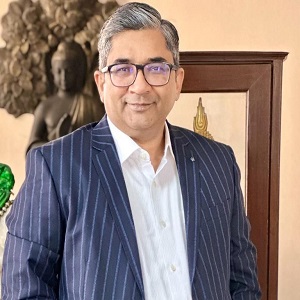Aligning Talent Development with Business Strategy: A Roadmap for Success
 Mohit Kumar, President Human resources, Hindalco Industries, in a recent interaction with Higher Education Review, shares his views on how organizations can ensure that their talent development initiatives directly support their overall business strategy and what methods can be used to identify the specific skills needed to drive business objectives, how leadership development programs can be tailored to reflect the organization's strategic priorities and how important is it for leaders to actively participate in talent development initiatives and more.
Mohit Kumar, President Human resources, Hindalco Industries, in a recent interaction with Higher Education Review, shares his views on how organizations can ensure that their talent development initiatives directly support their overall business strategy and what methods can be used to identify the specific skills needed to drive business objectives, how leadership development programs can be tailored to reflect the organization's strategic priorities and how important is it for leaders to actively participate in talent development initiatives and more.
Mohit is a business-focused HR leader with a dynamic 28-year career steering organisations through complex transitions and building an empowered and talented workforce in cross-cultural environments in highly competitive industries. He has proven expertise in defining organisational structures and human capital requirements to align HR functions with business goals, providing the catalyst to enhance capability, enable culture, optimise performance and drive revenue and profit growth. Trusted advisor to senior management and human-centred change agent who develops organizational initiatives that accelerate the achievement of business goals with an eye on the bottom line.
How can organizations ensure that their talent development initiatives directly support their overall business strategy and what methods can be used to identify the specific skills needed to drive business objectives?
It is crucial to become completely engaged in the overall business strategy in order to be successful. This forms one of the key aspects of organizational success, while the second aspect comprises strategic workforce planning that goes beyond conventional staffing approaches. It also encompasses anticipating as well as envisioning the future landscape by understanding both the supply as well as demand of the talent and also determining how to meet those requirements, effectively.
Numerous questions must be addressed in strategic workforce planning such as what talents will the firm need for acquiring externally? Which skills can be developed internally via training & up skilling initiatives? What emerging skills will be important in the future and where can these skills be sourced?
For instance, if the firm operates in the manufacturing industry, it must stay ahead of technological advancements in the manufacturing processes. Furthermore, the surge in the integration of digital solutions in operations will require us to assess the evolving needs in the digital space. Therefore, we can determine what kind of skillsets & talents will be necessary for the firm’s future growth and competitiveness by analyzing what is changing in both the manufacturing as well as digital realms.
A successful workplace planning is about finding a balance between buying and building talent and deciding which skills are sourced better externally through recruitment and which skills can be nurtured internally. It is a continuous process which helps in ensuring that the organization is not just prepared for the present market but it is also positioned well for the challenges & opportunities of the future.
In what ways can leadership development programs be tailored to reflect the organization's strategic priorities and how important is it for leaders to actively participate in talent development initiatives?
The role of leaders goes beyond merely giving feedback. It involves walking alongside talent throughout the development journey of the employee. True success is always achieved by design and not by chance. For instance, we selected the best talent from our internal pool as well as collaborated closely with the leaders of the organization who are the current executives and members of the Executive Committee (XCOM), when we built our own CXO pipeline. Together, we identified the important skills which the potential successors will require for stepping into these roles in the near future.
We adopted a two-pronged approach where first we would identify the broad skills that all future leaders would require and secondly we address specific developments requirements through individualized coaching. The journey lasted for two years and it was categorized into numerous modules, each focusing on various aspects of leadership development.
The first module was centered on self-awareness, which is a fundamental skill for leadership. This five-day program helped the participants deepen their self-awareness as well as enhance their ability to collaborate in teams. The second module is on leading people which focuses on the application of “heart skills”, which is the interpersonal skill that is crucial for effective leadership. The third experience was an immersive learning journey. In this we took participants to Tanjore for exploring the legacy of the Chola Empire. They engaged in a session with the current king, focusing on the concept of power, particularly on how to wield power responsibly once it is attained. This immersive experience highlights the moral & ethical dimensions of leadership, specifically when occupying positions of influence.
Furthermore, we also recognized the need for leaders to possess a solid understanding of business acumen, specifically in the area of finance. We also, introduced a module on financial literacy. Here the participants were trained in reading balance sheets and understanding financial health indicators as well as making informed financial decisions, regardless of their function with the company. This helped in ensuring that all leaders from various departments understood the financial implications of their decisions.
An exciting outcome of this program was that most of these newly developed leaders today are mentoring the next generation of the leaders who are present within the organization. This has helped in creating a sustainable cycle of leadership development and this mentoring ensures that knowledge and skills are passed down continuously strengthening the leadership pipeline of the company.
Technology plays a crucial role by enabling personalized learning paths, what role does technology play in aligning talent development with business strategy?
While talent development requires to be aligned with the overall business strategy, data & analytics play a major role in achieving this alignment by offering sharper insights coupled with a clearer understanding of learning requirements, specifically when managing large-scale programs within a company. From a company’s perspective, data analytics can help in identifying the precise learning interventions that are needed for developing the necessary skills. Also, organizations can pinpoint specific segments where development is required, making learning programs more focused, effective as well as relevant. This approach helps ensure that the learning initiatives are aligned with the business objectives and closes any current skill gaps in a more targeted manner.
The abundance of learning programs and opportunities available today can be overwhelming for individual learners, on the other hand. Analytics can render insights into the current skills of the learner and suggest the most relevant programs which meet their specific requirements, which helps ensure that learners can choose programs which offer the greatest value and these, are most aligned with their personal development goals.

